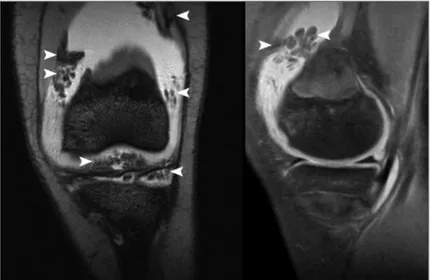iMAgENS EM REUMATOLOgiA
ÓRgÃO OFiCiAL DA SOCiEDADE PORTUgUESA DE REUMATOLOgiA
86
Lipoma Arborescens: a rare cause of recurrent
synovial hydrathrosis at paediatric age
ACTA REUMATOL PORT. 2016;41:86-87
A 14 year-old female patient with a history of autoim-mune haemolytic anemia diagnosed at the age of 3, re-fractory to the corticosteroids and immunosuppressive treatment, requiring splenectomy, was referred to the Paediatric Rheumatology Department with a swollen and painful left knee. The radiographic study was nor-mal but the ultrasound was suggestive of synovial ef-fusion with proliferation of the synovial membrane in the suprapatellar recess. The arthrocentesis showed a non-inflammatory fluid. The patient underwent a joint injection with triamcinolone hexacetonide. Due to fre-quent recurrences, despite the local gestures, Magne tic Resonance Magina (MRI) was requested (Figure 1 and 2), which revealed fat proliferation of the synovial membrane, suggestive of lipoma arborescens. She was submitted to arthroscopic synovectomy with complete resolution of the clinical picture. The anatomopatho-logical examination revealed a fibroadipose synovial membrane with sparse and nonspecific chronic in-flammatory lesions.
Lipoma arborescens is an intra-articular benign and rare condition of unknown aetiology, characterized by the diffuse substitution of the synovial tissue by ma-ture adipocytes, resulting in a villous lipomatous pro-liferation1.
Although more common in the knee2, it may appear
in other joints or even bursae3or tendon sheaths4. It’s
more frequent in males, between the fifth and sixth decades, and usually occurs as a painless swelling with intermittent exacerbations1.
It’s usually ascribed to a reactive process associated
with chronic inflammation, though there are cases that occur without any known aetiological factors, suggest-ing the possibility of a primary form of the disease2.
It is a rare and probably underdiagnosed pathology that must be considered in the differential diagnostic of any arthritis, mainly of knee monoarthritis. In particu-lar, this clinical case warns to the fact that not always the arti cular affection in the paediatric patient with an immune mediated disease is of autoimmune aetiology. The refractoriness to local gestures, usually effective in these pictures, forces a more thorough evaluation.
In the differential diagnosis of monoarthritis all the pathologies resulting in joint effusion and synovial
Rodrigues C1, Cadilha R2, Aguiar F3, Brito I4
FIGURE 1.MRI showing a proliferation (arrow heads) suggestive of lipoma arborescens
1. Serviço de Medicina Física e de Reabilitação, Centro Hospitalar de Trás-os-Montes e Alto Douro
2. Serviço de Medicina Física e de Reabilitação, Centro Hospitalar de São João
ÓRgÃO OFiCiAL DA SOCiEDADE PORTUgUESA DE REUMATOLOgiA
87 RodRigues C et al
thickening, without systemic involvement, must be in-cluded, namely: pigmented villonodular synovitis, synovial hemangioma, synovial osteocondromatosis and synovial lipoma5.
The MRI is, usually, enough to diagnose this entity, being the remaining imaging studies nonspecific1. The
anatomopathologic aspect is of a frond-like fatty mass with a villous pattern, and a moderate number of mononuclear inflammatory cells may be present5.
The surgical synovectomy is almost always cura-tive1,5.
coRREspondEncE to
C Rodrigues
Serviço de Medicina Física e de Reabilitação, Centro Hospitalar de Trás-os-Montes e Alto Douro E-mail: cjrodrigues@gmail.com
REFEREncEs
1. Bernardo A, Bernardes M, Brito I, Vieira A, Ventura F. Lipoma Arborescente da Sinovial. Acta Méd Port 2004; 17: 325-328 2. Howe BM, Wenger DE. Lipoma arborescens: comparison of
ty-pical and atyty-pical disease presentations. Clinical radiology 2013; 68: 1220-1226
3. Kim MH, Chung SW, Yoon JP, Kim SH, Oh JH. Subdeltoid li-poma arborescens combined with rotator cuff tears. Orthope-dics 2013; 36: e1103-1107
4. Kamaci S, Ergen FB, Leblebicioglu G. Lipoma arborescens in the extensor tendon sheath of the hand secondary to foreign body reaction. J Hand Surg Eur Published Online First: 23 Ja-nuary 2014. doi: 10.1177/1753193414521131
5. Finotti LT, Araújo DB, Vituli LF, Dalva R, Giorgi N, Chahade WH. Lipoma Arborescente Sinovial. Acta Reumatol Port 2011; 36: 171-175

